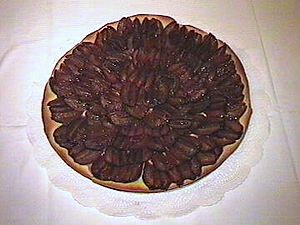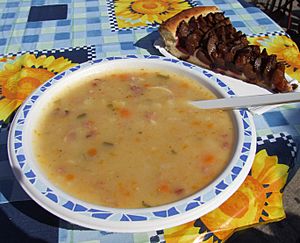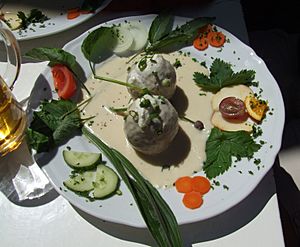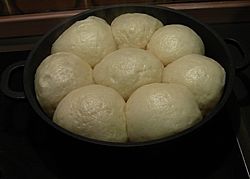Palatine cuisine facts for kids
The cuisine of the Palatinate is all about the special foods and dishes from this region in Germany. Many of these foods have become famous not just in the Palatinate, but in other places too!
Contents
Traditional Palatinate Food
Traditional Palatinate food is often very hearty and filling. This is because the recipes were created by people who worked hard physically. Some dishes also came from times when people didn't have much money. Compared to other German foods, Palatinate dishes can be spicier. A common spice used for sausages and potatoes is marjoram.
Meat Dishes
The most famous dish from the Palatinate is Saumagen. This name means "pig's stomach." It's a mix of lean pork, sausage meat, potatoes, onions, marjoram, cloves, and pepper. This mixture is cooked inside a casing, which was traditionally a pig's stomach.
There are many ways to make Saumagen with different ingredients. After it's cooked, it's cooled down and sliced. You can find it at most butcher shops in the Palatinate. The slices are usually fried and served with sauerkraut and bread, or with mashed potatoes and brown sauce.
Other important meat dishes in Palatinate cooking include:
- Coarse Bratwürste (grilled sausages)
- Liverwurst (a type of sausage made from liver)
- Blood sausage
- Liver Knödel (dumplings)
- Meatballs, often served with a horseradish sauce.
Sauerkraut is a common side dish all year, especially in winter. Mashed potatoes and brown sauce are also popular with main dishes. Many restaurants serve rye bread instead of mashed potatoes.
A very famous combination of dishes is called Pfälzer Dreifaltigkeit. This means "Palatinate Trinity." It includes three well-known dishes: Saumagen, the typical Bratwurst, and liver Knödel.
Fish Dishes
In the Middle Ages, many small streams from the Palatinate Forest were used to create fish ponds. This was done by monasteries and peasants. Even though many of these ponds are gone, some traditional restaurants in the forest still serve different kinds of fish. Today, you can find modern fish types along with traditional ones like trout, roach, zander, pike, and carp.
Another important fishing tradition was along the Rhine river. Before industrialization, the Rhine had many fish. Fishermen in the city of Speyer even had their own special group, called a guild. They caught many types of fish, but salmon and eel were very important. Sadly, the Rhine became polluted during industrialization. Many fish could no longer live there, or the fish were not safe to eat.
Even after losing their fishing grounds, people in the Palatinate still loved fish. Today, many restaurants along the Rhine specialize in fish dishes. Many villages still have traditional fishermen's feasts, where they offer a wide variety of fish.
Other Popular Foods

A very famous dish from the Palatinate is Dampfnudeln. These are "steamed noodles" with a salty crust. They are usually a main dish. You can eat them with sweet side dishes like wine sauce, vanilla sauce, or fruit preserves (like mirabelle plums or pears). Or, you can eat them with savory side dishes like potato soup, vegetable soup, or goulash.
In some parts of the Palatinate, people even eat Dampfnudeln as an appetizer with a savory soup. Then, they have them again with sweet side dishes as the main meal.
During plum season, a common main dish is "Grumbeersupp und Quetschekuche." This is potato soup and plum cake. For dessert, Kerscheplotzer is often served. Another seasonal dish is Zwiebelkuchen (onion cake), which is often eaten with Federweisser (new wine) in autumn.
Gebreedelde are also eaten very often. This is the Palatinate way of making baked potatoes with diced bacon or liverwurst. Boiled potatoes with quark (a type of cheese), onions, caraway, pepper, or chives are also very popular.
A traditional snack for vineyard workers is Weck, Worscht un Woi. This means "bun, meat, and wine."
Regional Food Differences
Anterior and South Palatinate
The most important product here is wine. It is grown along the Weinstraße (Wine Route). The mild climate in this area is perfect for growing grapes.
Traditional white wines include Riesling, Müller-Thurgau, Silvaner, and Kerner. Famous red wines are Blauer Portugieser and Dornfelder. Wines are not just for drinking; they are also used in sauces and desserts.
Many chestnut trees grow in the Haardt mountains. So, the food in this region features many chestnut dishes, especially in autumn and around Christmastime. Chestnuts are often served with game meats like duck or rabbit. Cooks in fancy restaurants have also started using chestnut dishes from Italy and France.
Important vegetables grown here are potatoes and asparagus in the Rhine valley. Because of the warm climate, you can also find almonds, kiwis, citron fruit, and figs. This makes the food here similar to dishes from Mediterranean countries like Italy, Spain, and especially France.
People in the Palatinate love good food, just like the French. You can see this at public festivals and funfairs, which often celebrate food or drink. Besides the many wine festivals, there are also special festivals for foods like asparagus in Dudenhofen, pretzel in Speyer, radish in Schifferstadt, Handkäse (a type of cheese) in Lustadt, cherry in Grünstadt-Sausenheim, potato in Bellheim, or the Saumagen dish in Kallstadt.
West Palatinate
The food in this region is even heartier. Traditional dishes include:
- Hooriche: This means "hairy." They are small potato balls served with a cream and bacon sauce.
- Schales: A dish made mostly from raw shredded potatoes, bacon, onions, and lots of nutmeg. It's usually baked in a bread pan and often served with apple sauce.
- Lakzervelat: A type of sausage made from cured meat. It's especially common between Christmas and New Year's Eve.
- Anduddel: Another very spicy sausage that is good for stews.
Border to France
In the region next to France, you can see the influence of French cooking. Dishes like Flammkuchen (a thin pizza-like dish) are very popular. Even escargots (snails) are common here.
See also
 In Spanish: Gastronomía del Palatinado para niños
In Spanish: Gastronomía del Palatinado para niños






